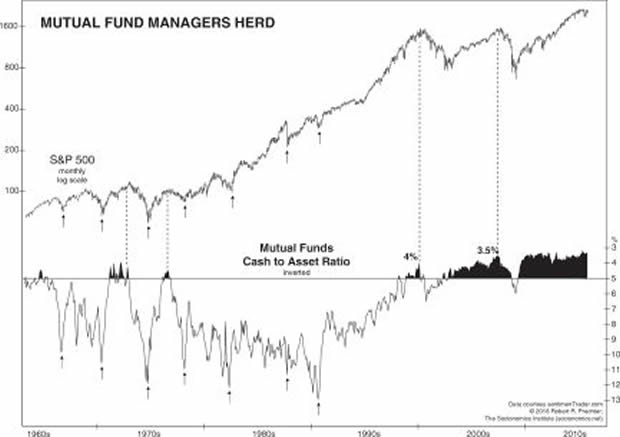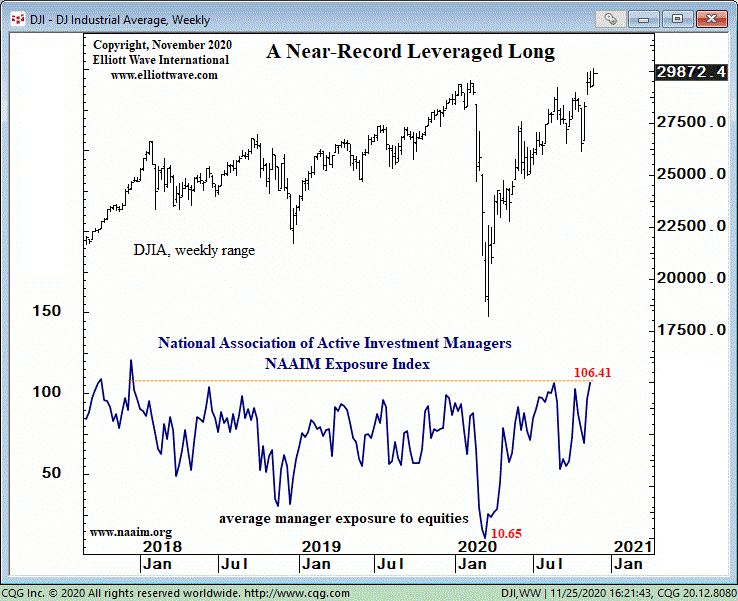Yes, "Active Stock Investment Managers" DO Behave Like the "Crowd"
Stock-Markets / Stock Markets 2020 Dec 13, 2020 - 06:41 PM GMTBy: EWI
...and that's not a good thing
When people hear the phrase "investing crowd," they tend to think of Main Street investors. Usually dipping their toe in the water after the trend has been underway for quite some time, they are typically seen as the "more cautious" types than Wall Street pros.
Of course, there is a flip side to that "cautiousness": The "investing crowd" is known for panic-selling near market bottoms and going "all in" near major market tops.
What's more, Main Street investors are not alone in their "crowd" behavior. It actually permeates most of the investment world, including the professionals.
For example, one might think that professional money managers -- with all their education and experience -- would take a more reflective and independent stance when considering investment ideas.
But the evidence shows that investment professionals herd like most everyone else.
Here's a chart and commentary from Robert Prechter's 2017 book, The Socionomic Theory of Finance:

It is widely known that professional money managers, in the aggregate, fail to beat the market. The result is not, as some theorists say, because the market moves randomly. It is because most professionals are herding, right along with other speculators. [The chart shows] that at good prices for buying stock, mutual fund managers have high levels of cash, and at good prices for selling, they have low levels of cash. This record confirms that they consistently do the opposite of what they should be doing for maximum return.
This chart from Elliott Wave International's Nov. 25 U.S. Short Term Update, a thrice weekly publication which provides near-term forecasts for major U.S. financial markets, shows another way that active investment managers herd. Here's the commentary:

The current reading of 106.41 in the National Association of Active Investment Managers Exposure Index is compatible with the extreme readings in the II Survey and the equity p/c ratio. A 100 reading in the Exposure Index means that active managers are fully invested in equities. A level of 106.41 means managers are more than fully invested; they are leveraged long. ... Notice managers' equity position in March of this year, just 10.65. Active managers herd like all investors. They become more optimistic as stocks rally and more pessimistic as stocks decline.
When the stance of active investment managers reaches an extreme, it's usually a sign that a trend reversal is just around the corner.
At times, however, such "extremes" can persist.
What does today's extreme mean? For answers, it's best to also consult the Elliott wave model. When sentiment measures and a market's Elliott wave pattern are in agreement, a market juncture like today's can be made with even greater confidence.
If you'd like to gain insights into Elliott wave patterns, you are encouraged to read the Wall Street classic book, Elliott Wave Principle: Key to Market Behavior, by Frost & Prechter. Here's a quote:
[R.N.] Elliott himself never speculated on why the market's essential form is five waves to progress and three waves to regress. He simply noted that that was what was happening. Does the essential form have to be five waves and three waves? Think about it and you will realize that this is the minimum requirement for, and therefore the most efficient method of, achieving both fluctuation and progress in linear movement. One wave does not allow fluctuation. The fewest subdivisions to create fluctuation is three waves. Three waves (of unqualified size) in both directions would not allow progress. To progress in one direction despite periods of regress, movements in that direction must be at least five waves, simply to cover more ground than the intervening three waves. While there could be more waves than that, the most efficient form of punctuated progress is 5-3, and nature typically follows the most efficient path.
Good news: You can access the entirety of the online version of Elliott Wave Principle: Key to Market Behavior for free.
Simply follow this link: Elliott Wave Principle: Key to Market Behavior -- free and unlimited access.
This article was syndicated by Elliott Wave International and was originally published under the headline Yes, "Active Investment Managers" DO Behave Like the "Crowd". EWI is the world's largest market forecasting firm. Its staff of full-time analysts led by Chartered Market Technician Robert Prechter provides 24-hour-a-day market analysis to institutional and private investors around the world.
© 2005-2022 http://www.MarketOracle.co.uk - The Market Oracle is a FREE Daily Financial Markets Analysis & Forecasting online publication.



